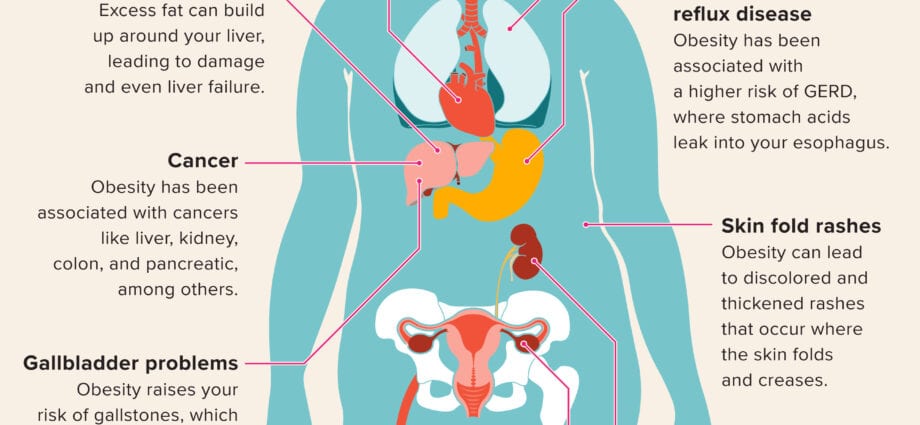Contents
Obesity develops gradually as a result of many months and years of poor dietary habits and inactivity. Most people strive to reduce body fat in order to become slimmer and more attractive, but appearance is far from the main problem for obese people. Fat in the human body is not homogeneous. It accumulates not only under the skin, but also on internal organs, deposited on the intestines, pancreas, liver, heart, and vascular walls. According to doctors, internal (visceral) fat carries a risk to health and life.
Obesity in women and men
Obesity looks different in women and men. Women have less visceral fat. Doctors believe that this is the reason for the higher average life expectancy of women. In the female body, before menopause, fat is deposited on the buttocks, lower abdomen and thighs, and not on the abdominal organs, when men accumulate fat there. Abdominal obesity in medicine is considered the most dangerous.
Since menopause destroys the hormonal defenses of the female body against excessive accumulation of abdominal fat, it is especially important for women to maintain a healthy weight during their age.
Why is visceral fat dangerous?
Enveloping the organs, it squeezes them, and with its high content, it is able to penetrate inside. For example, visceral fat clogs the walls of blood vessels, which leads to the development of atherosclerosis, which in turn leads to a heart attack or stroke. This applies not only to obese people, but also relatively slim. Visceral fat is invisible to the eye, even in people with a small percentage of subcutaneous fat.
Heart attacks and strokes are not the only health-critical consequences of excess body fat. Its excess makes changes in the hormonal background – increases the production of insulin and estrogen, suppresses the synthesis of growth hormone and testosterone.
Too much insulin puts a huge strain on the pancreas, and when it can’t handle it, diabetes develops. Most obese people are pre-diabetic, when cells lose their ability to produce insulin and blood sugar levels rise above normal. If you do not change your lifestyle and do not reduce the percentage of fat, then the development of type 2 diabetes within 5-10 years will be inevitable.
An excess of estrogen introduces a severe imbalance in the reproductive system. Menstrual irregularities are not only caused by diets, but often go hand in hand with obesity. Excess subcutaneous and visceral fat makes pregnancy impossible. In men, excess estrogen and suppression of testosterone synthesis impairs potency and leads to infertility.
According to doctors, obese people are at risk of dying in their sleep from respiratory arrest. When clinically overweight, apnea syndrome occurs in most people.
To this list it is worth adding vascular diseases – hypertension and varicose veins, which also develop against the background of excess weight.
How to determine the level of internal fat in yourself?
People who are overweight can roughly know the level of danger of excess internal fat. To do this, you need to measure the waist circumference.
- The norm for women is up to 88 cm;
- The norm for men is up to 94 cm.
If you see that fat in your body accumulates on your stomach, and your waist circumference exceeds the above norms, then you are at risk, you need to urgently change your lifestyle.
However, this problem is typical not only for obese people, so the most accurate way to find out the composition of your body is to undergo a diagnosis at a medical center.
Reducing the percentage of body fat by at least 10% will minimize health risks and restore hormonal function. To do this, you need to change your diet and start moving more. At the beginning of losing weight, the body will give up excess weight well, but then the process will slow down. Then you will need to recalculate the calorie deficit to the new weight and increase the calorie expenditure through training and non-training activities.










